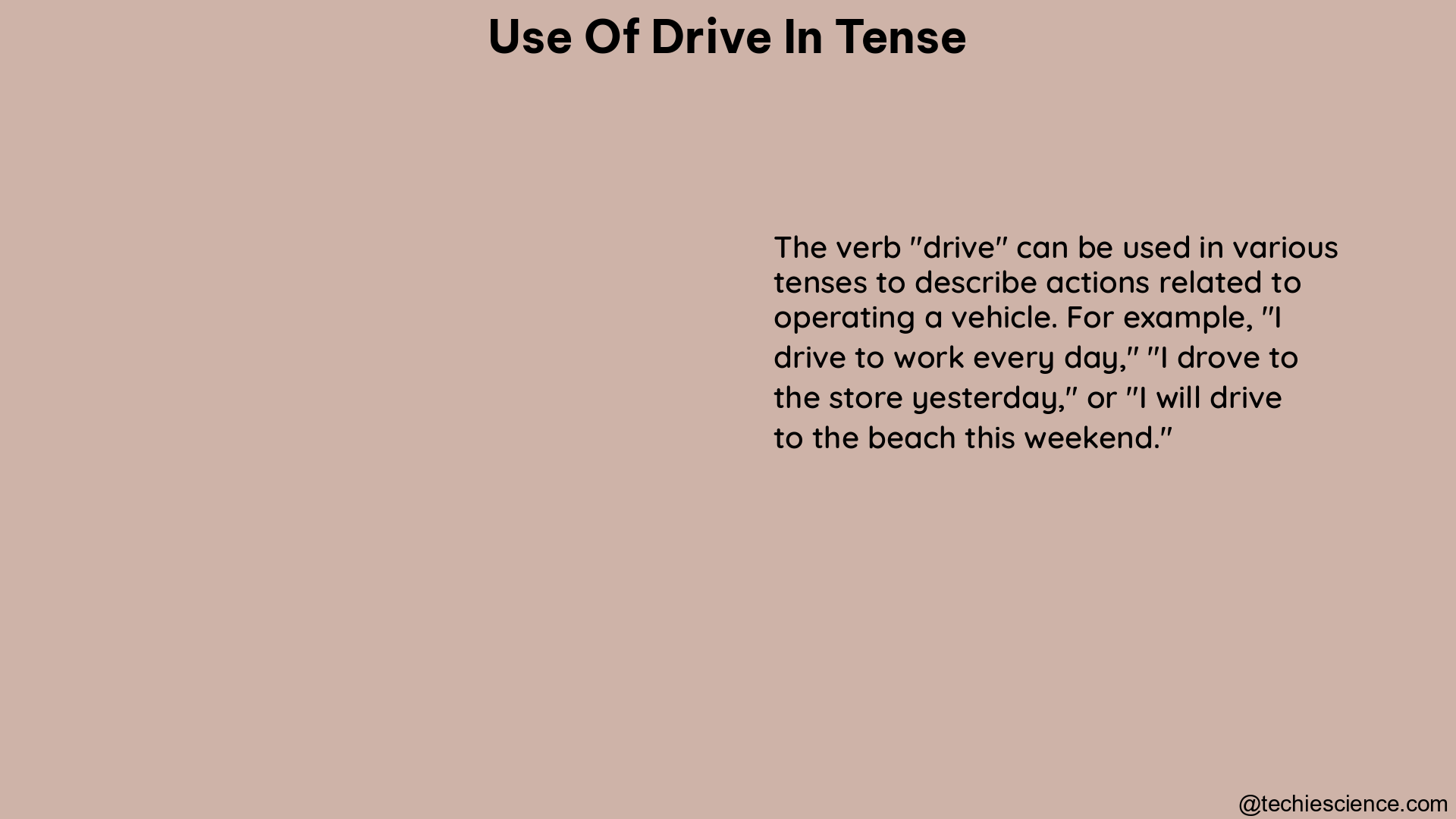The verb “drive” is an essential part of the English language, but its usage in different tenses can be complex and challenging for learners. This comprehensive guide will delve into the intricacies of using “drive” in various tenses, providing a detailed and practical resource for English students and enthusiasts.
Base Form and Infinitive
The base form of the verb “drive” is simply “to drive.” This is the infinitive form, which is used to express the action of driving without any specific time reference.
Example:
– It is important to drive safely on the road.
Past Tense

Past Simple
The past simple tense of “drive” is “drove.” This form is used to express an action that occurred in the past.
Example:
– I drove to work early this morning.
Past Participle
The past participle of “drive” is “driven.” This form is used in perfect tenses, such as the present perfect and past perfect.
Example:
– I have driven to the store before.
Present Tense
Present Simple
The present simple tense of “drive” is “drives.” This form is used to express habitual or regular actions.
Example:
– He drives to work every day.
Present Continuous
The present continuous tense of “drive” is “is driving.” This form is used to express an action that is happening at the moment of speaking.
Example:
– He is driving to work right now.
Present Perfect Simple
The present perfect simple tense of “drive” is “has driven.” This form is used to express an action that has been completed in the past, but the results are still relevant in the present.
Example:
– He has already driven half way there.
Present Perfect Continuous
The present perfect continuous tense of “drive” is “has been driving.” This form is used to express an action that has been ongoing for a period of time and is still continuing.
Example:
– He has been driving since 7.00 am.
Future Tense
Future Simple
The future simple tense of “drive” is “will drive.” This form is used to express an action that will occur in the future.
Example:
– He will drive his colleague to work tomorrow.
Future Continuous
The future continuous tense of “drive” is “will be driving.” This form is used to express an action that will be in progress at a specific time in the future.
Example:
– He will be driving to work again tomorrow.
Future Perfect Simple
The future perfect simple tense of “drive” is “will have driven.” This form is used to express an action that will be completed by a certain time in the future.
Example:
– He will have driven his colleague to work for over a year now.
Future Perfect Continuous
The future perfect continuous tense of “drive” is “will have been driving.” This form is used to express an action that will have been ongoing for a period of time by a certain time in the future.
Example:
– By the time he gets to work at 8.10 am, he will have been driving for over an hour.
Imperative
The imperative form of “drive” is simply “drive.” This form is used to give a direct command or instruction.
Example:
– Let’s drive down to the beach.
Passive Voice
The passive voice of “drive” is “is/was driven.” This form is used to express an action that is performed on the subject, rather than by the subject.
Example:
– The car was driven by the valet.
Perfect Tenses
Present Perfect
The present perfect tense of “drive” is “has driven.” This form is used to express an action that has been completed in the past, but the results are still relevant in the present.
Example:
– They have driven for hours to reach the coast.
Past Perfect
The past perfect tense of “drive” is “had driven.” This form is used to express an action that was completed before another past action or event.
Example:
– He had driven the route numerous times before.
Future Perfect
The future perfect tense of “drive” is “will have driven.” This form is used to express an action that will be completed by a certain time in the future.
Example:
– By tomorrow, we will have driven through all five states.
Synonyms
There are several synonyms for the verb “drive,” including:
– Operate
– Steer
– Pilot
– Navigate
Notable Usage
The verb “drive” can also be used in a figurative sense to express motivation or ambition. For example, “He is driven by a thirst for knowledge” or “Her ambition has driven her to succeed.”
Conjugation Table
For a comprehensive conjugation table of the verb “drive,” you can refer to the Collins Dictionary website: https://www.collinsdictionary.com/us/conjugation/english/drive.
Examples in Sentences
Throughout this guide, various examples have been provided to demonstrate the use of “drive” in different tenses and contexts. These examples should help you better understand the practical application of the verb.
Reference Links
- https://preply.com/en/question/past-tense-of-drive-55893
- https://englishteachersite.com/whats-the-past-tense-of-drive-drive-drove-or-driven/
- https://www.learnenglish.de/vocabulary/tenses/drivetense.html
- https://www.collinsdictionary.com/us/conjugation/english/drive
By mastering the use of “drive” in various tenses, you will be able to express yourself more accurately and confidently in English. This comprehensive guide should serve as a valuable resource for your language learning journey.
Hello Everyone…My name is Sulogna Mahapatra. I have completed my master’s in English along with a B.Ed. I have 2 years of teaching experience in a school. I am also a creative writer. Presently I am working as a Subject Matter Expert in Lambdageeks.
Let’s connect through LinkedIn: